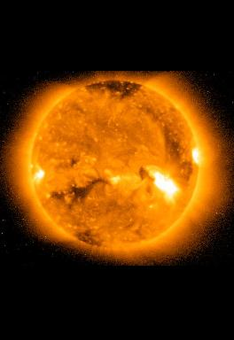NOAA/WDS Paleoclimatology - 9400 Year Cosmogenic Isotope Data and Solar Activity Reconstruction
This archived Paleoclimatology Study is available from the NOAA National Centers for Environmental Information (NCEI), under the World Data Service (WDS) for Paleoclimatology. The associated NCEI study type is Forcing. The data include parameters of climate forcing with a geographic location of Global. The time period coverage is from 9389 to -27 in calendar years before present (BP). See metadata information for parameter and study location details. Please cite this study when using the data.
Dataset Citation
- Cite as: Steinhilber, F.; Abreu, J.; Beer, J.; Brunner, I.; Christl, M.; Fischer, H.; Heikkilä, U.; Kubik, P.W.; Mann, M.E.; McCracken, K.G.; Miller, H.; Miyahara, H.; Oerter, H.; Wilhelms, F. (2012-04-04): NOAA/WDS Paleoclimatology - 9400 Year Cosmogenic Isotope Data and Solar Activity Reconstruction. [indicate subset used]. NOAA National Centers for Environmental Information. https://doi.org/10.25921/ytyh-f437. Accessed [date].
- Please refer to Credit tab for full citation information.
Dataset Identifiers
- doi:10.25921/ytyh-f437
- noaa-forcing-12894
- NCEI DSI 1200_02
- NCEI DSI 1200_01
ISO 19115-2 Metadata
noaa-forcing-12894
| Search Data |
|
| Download Data |
|
| Distribution Formats |
|
| Ordering Instructions | Contact NCEI for other distribution options and instructions. |
| Distributor |
NOAA National Centers for Environmental Information ncei.info@noaa.gov |
| Dataset Point of Contact |
NOAA National Centers for Environmental Information ncei.info@noaa.gov |
| Dataset Point of Contact | Data Center Contact NOAA World Data Service for Paleoclimatology 828-271-4800 paleo@noaa.gov |
| Coverage Description | Date Range: 9389 cal yr BP to -27 cal yr BP; |
| Time Period | -7439 to 1977 |
| Spatial Bounding Box Coordinates |
West: -180
East: 180
South: -90
North: 90
|
| Spatial Coverage Map |
| General Documentation |
|
| Associated Resources |
|
| Publication Dates |
|
| Data Presentation Form | Digital table - digital representation of facts or figures systematically displayed, especially in columns |
| Dataset Progress Status | Complete - production of the data has been completed |
| Data Update Frequency | Data update frequency not available |
| Supplemental Information | STUDY NOTES: Records of common production rate of cosmogenic radionuclides, cosmic ray intensity (solar modulation) and solar activity (total solar irradiance) during the past 9400 years. Common production rate (Figure 3), solar modulation (Figure S13) and total solar irradiance (Figure S14) during the past 9400 years. The records are based on several radionuclide records with high temporal resolution (years) from different sites and of different types (10Be from Antarctica and Greenland, 14C from tree rings). The data are 22-year averages. The common signal is the first principal component which was extracted with principal component analysis. These data are an update to Steinhilber et al. 2009 total solar irradiance data, also archived at the World Data Center for Paleoclimatology: https://www.ncei.noaa.gov/pub/data/paleo/climate_forcing/solar_variability/steinhilber2009tsi.txt ABSTRACT SUPPLIED BY ORIGINATOR: Understanding the temporal variation of cosmic radiation and solar activity during the Holocene is essential for studies of the solar-terrestrial relationship. Cosmic-ray produced radionuclides, such as 10Be and 14C which are stored in polar ice cores and tree rings, offer the unique opportunity to reconstruct the history of cosmic radiation and solar activity over many millennia. Although records from different archives basically agree, they also show some deviations during certain periods. So far most reconstructions were based on only one single radionuclide record, which makes detection and correction of these deviations impossible. Here we combine different 10Be ice core records from Greenland and Antarctica with the global 14C tree ring record using principal component analysis. This approach is only possible due to a new high-resolution 10Be record from Dronning Maud Land obtained within the European Project for Ice Coring in Antarctica in Antarctica. The new cosmic radiation record enables us to derive total solar irradiance, which is then used as a proxy of solar activity to identify the solar imprint in an Asian climate record. Though generally the agreement between solar forcing and Asian climate is good, there are also periods without any coherence, pointing to other forcings like volcanoes and greenhouse gases and their corresponding feedbacks. The newly derived records have the potential to improve our understanding of the solar dynamics and to quantify the solar influence on climate. |
| Purpose | Records of changes in solar irradiance, volcanic aerosols, atmospheric trace gases, and other properties thought to influence climate in the past. Parameter keywords describe what was measured in this dataset. Additional summary information can be found in the abstracts of papers listed in the dataset citations. |
| Dataset Citation |
|
| Cited Authors |
|
| Originators |
|
| Publishers |
|
| Theme keywords |
Global Change Master Directory (GCMD) Science Keywords
|
| Data Center keywords |
Global Change Master Directory (GCMD) Data Center Keywords
|
| Place keywords |
|
| Use Constraints |
|
| Access Constraints |
|
| Fees |
|
Last Modified: 2024-10-31
For questions about the information on this page, please email: ncei.info@noaa.gov
For questions about the information on this page, please email: ncei.info@noaa.gov

